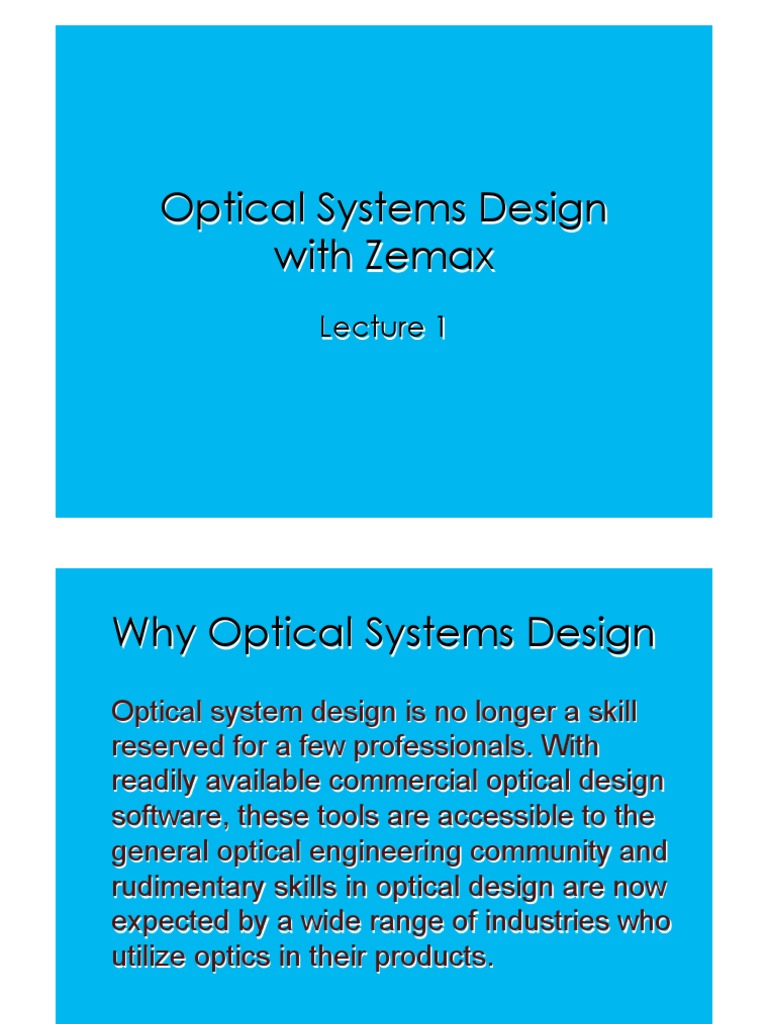In the dynamic realm of optical design, Zemax has emerged as a cornerstone tool for engineers and researchers alike. As a sophisticated optical design software, it empowers users to create intricate models, analyze optical systems, and simulate light propagation with unparalleled precision. Yet, diving into the depths of Zemax can initially feel daunting. Fortunately, the digital landscape is rich with resources that promise to transform your understanding and capabilities. Herein lies an exploration of commendable online resources tailored for acquiring proficiency in Zemax.
1. Official Zemax Website and Documentation
The first stop for any learner should always be the source. The official Zemax website offers not only a wealth of documentation but also an array of tutorials designed for users ranging from novices to seasoned experts. The comprehensive User Guide elucidates the software’s various functionalities, while the Knowledge Base provides insights into frequently encountered challenges and their solutions. Furthermore, users will find updates and enhancements, ensuring they remain cognizant of the latest developments in the software.
2. Online Course Platforms
For structured learning, numerous online course platforms present courses dedicated to Zemax. Websites such as Coursera and Udemy frequently offer classes that cover the basics as well as advanced techniques. These courses typically feature video lectures, quizzes, and hands-on projects, fostering an interactive learning environment. Courses can also introduce niche areas—for instance, optimizing optical systems or exploring geometrical optics—enabling learners to specialize in their interests.
3. Educational Institutions and MOOCs
Many universities now offer Massive Open Online Courses (MOOCs) that incorporate Zemax into their optics or engineering curricula. These courses harness the collaborative spirit of online education, allowing students to engage with peers and instructors while delving into theoretical concepts and practical applications. Institutions like MIT OpenCourseWare or edX often include segments on optical design software that cater to diverse learning preferences.
4. YouTube and Video Tutorial Channels
For those who thrive on visual learning, YouTube is an unparalleled reservoir of instructional content. Several channels specialize in optics and Zemax tutorials, presenting complex topics in digestible formats. From foundational tutorials outlining the user interface to advanced simulations showcasing real-world applications, these videos can significantly enhance comprehension. The interactive nature of video content also encourages viewers to pause, rewind, and revisit challenging sections until proficiency is achieved.
5. Forums and Community Boards
The journey of mastering Zemax becomes markedly easier when shared with a community. Online forums such as Stack Exchange and dedicated Zemax forums provide platforms for users to pose questions, share insights, and offer solutions. Engaging with a community of like-minded individuals not only helps in troubleshooting but also exposes learners to diverse perspectives and innovative techniques. The collaborative exchange fosters a deeper appreciation for the intricacies inherent in optical design.
6. Webinars and Live Tutorials
Numerous organizations and educational institutions host live webinars focusing on specific aspects of Zemax. These interactive sessions often feature experienced industry professionals who share their knowledge and answer audience questions in real-time. Attending these webinars allows learners to gather insights about practical applications, industry trends, and optimization strategies, thereby enriching their overall understanding. The immediacy of live interaction can also lead to spontaneous bouts of inquiry that may not arise in a pre-recorded format.
7. Research Articles and Case Studies
Diving into scholarly articles and case studies can elucidate how Zemax is being utilized in cutting-edge research and innovative projects. Platforms like ResearchGate and academia.edu house a plethora of articles that discuss specific applications of Zemax in diverse fields such as biomedical optics, astronomy, and telecommunications. Reading these resources enhances theoretical knowledge and provides context for practical applications, establishing a bridge between learning and real-world challenges.
8. Books and eBooks
While online resources are invaluable, traditional literature remains a staple for comprehensive understanding. Numerous textbooks have been devoted to the nuances of optical design using Zemax. Titles often address both basic and advanced concepts, guiding readers through systematic procedures to harness the software’s full potential. Libraries or eBook platforms commonly possess a rich selection of pertinent texts, emphasizing both practical applications and theoretical underpinnings.
9. Blogs and Informative Websites
A growing number of optics-focused blogs and websites share insights, tips, and tutorials on Zemax. Authors frequently explore diverse topics—ranging from common pitfalls in optical design to ingenious strategies for system optimization. Engaging with such content can inspire innovative approaches to familiar challenges, encouraging the integration of creativity into technical processes. The informal nature of blogs often allows for a fresh perspective, unburdened by the constraints of formal academic writing.
10. Collaborative Projects and Internships
Lastly, one of the most effective ways to solidify knowledge of Zemax is through practical application. Engaging in collaborative projects or internships that demand the use of Zemax facilitates experiential learning. Whether through university-sponsored research projects or industry internships, hands-on experience not only reinforces theoretical knowledge but also equips learners with practical skills needed for navigating real-world scenarios. Seeking out such opportunities can catalyze personal growth within the field of optics.
In conclusion, embarking on the journey to master Zemax need not be an isolated endeavor. By leveraging a plethora of well-curated online resources—ranging from official documentation to community forums—learners can cultivate a comprehensive understanding of this powerful software. The interconnected nature of these resources promotes a transformative shift in perspective, encouraging curiosity and fostering innovation within the domain of optical design.










